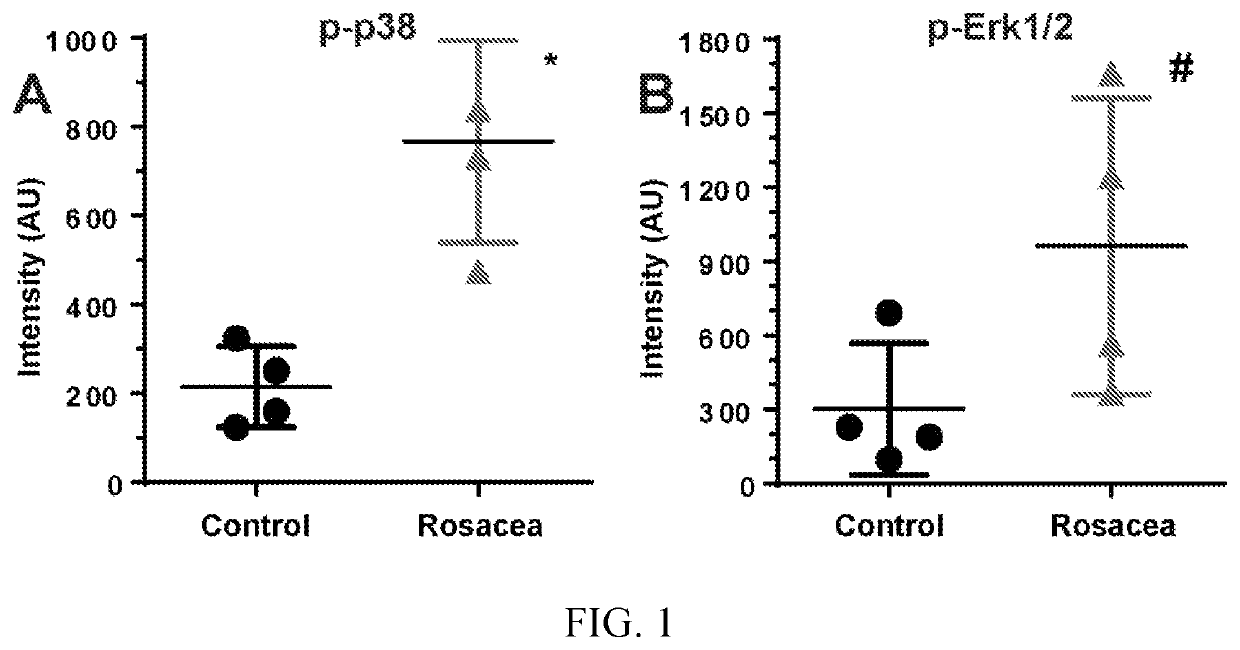Treatment of rosacea with P38 and Erk kinase pathway inhibitors
a technology of erk kinase and p38, which is applied in the field of rosacea treatment, can solve the problems of rosacea-like symptoms, insufficient prevention of inflammation for patients, pain and corneal damage,
- Summary
- Abstract
- Description
- Claims
- Application Information
AI Technical Summary
Benefits of technology
Problems solved by technology
Method used
Image
Examples
example 1
[0023]Methods
[0024]Biopsies and Protein Extraction
[0025]Cutaneous biopsies resulting from lower lid ectropion surgery were taken and analyzed. The protocol was reviewed and approved by the Albany Medical College Institutional Review Board, and adhered to the tenets of the Declaration of Helsinki. Immediately after resection of skin from patients with rosacea and from age- and gender-matched controls, the specimens were frozen at −80 C for later retrieval. A total of 34 samples were obtained, although three patients were excluded from the analysis due to lower lid malposition leading to excessive irritation.
[0026]Each sample was thawed, weighed, and processed for protein extraction. For that, 300 μl ice-cold lysis buffer containing 1% Triton X-100 (Sigma-Aldrich) in PBS containing protease and phosphatase inhibitor cocktails (Roche) and 50 mM pervanadate (Sigma-Aldrich) was added to the sample together with 250 mg of zirconia / silica beads (Biospec Products Int). Then samples were hom...
example 2
[0046]Wild type Balb / c mice of 6-8 weeks of age were used to determine the safety and efficacy of application of a cream containing an inhibitor of the Erk pathway. Animal studies were approved by the Albany Medical Center Institutional Review Board. The fur of the back was removed with an application of Nair. Three days later, three marks were made on the backs of the mice and treated with a cream containing trametinib (an Erk pathway inhibitor), vehicle cream (without an active ingredient) or nothing daily for five days. One hour after the last application, the spots were treated with one cream or the other, and cutaneous inflammation was induced via exposure to 1-Fluoro-2,4-dinitrobenzene (hereafter DNFB). Six hours later mice were euthanized and the skin spots were processed for histological analysis.
[0047]More specifically, to determine whether a cream containing an inhibitor of the Erk activation pathway would effectively penetrate the skin and protect it from an external inju...
PUM
| Property | Measurement | Unit |
|---|---|---|
| pH | aaaaa | aaaaa |
| temperature | aaaaa | aaaaa |
| concentrations | aaaaa | aaaaa |
Abstract
Description
Claims
Application Information
 Login to View More
Login to View More - R&D
- Intellectual Property
- Life Sciences
- Materials
- Tech Scout
- Unparalleled Data Quality
- Higher Quality Content
- 60% Fewer Hallucinations
Browse by: Latest US Patents, China's latest patents, Technical Efficacy Thesaurus, Application Domain, Technology Topic, Popular Technical Reports.
© 2025 PatSnap. All rights reserved.Legal|Privacy policy|Modern Slavery Act Transparency Statement|Sitemap|About US| Contact US: help@patsnap.com



